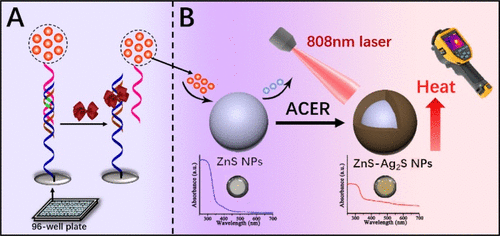当前位置:
X-MOL 学术
›
ACS Appl. Bio Mater.
›
论文详情
Our official English website, www.x-mol.net, welcomes your feedback! (Note: you will need to create a separate account there.)
In Situ Cation Exchange Generated ZnS–Ag2S Nanoparticles for Photothermal Detection of Transcription Factor
ACS Applied Bio Materials ( IF 4.7 ) Pub Date : 2020-04-07 , DOI: 10.1021/acsabm.0c00232 Tianyue Dai 1 , Yifei Wan 1 , Ruifen Tian 1 , Sicheng Wang 1 , Ting Han 1 , Guangfeng Wang 1
ACS Applied Bio Materials ( IF 4.7 ) Pub Date : 2020-04-07 , DOI: 10.1021/acsabm.0c00232 Tianyue Dai 1 , Yifei Wan 1 , Ruifen Tian 1 , Sicheng Wang 1 , Ting Han 1 , Guangfeng Wang 1
Affiliation

|
The photothermal reagent (PTA)-mediated point-of-care detection of disease biomarkers using thermometers as readout has attracted increasing attention, but complex modification or generation process of PTAs still limited their further applications. Herein, we report a photothermal detection platform in which the target recognition triggered the in situ generation of the PTA and ZnS–Ag2S nanoparticles (NPs) by one-step autonomous cation exchange reaction (ACER). As a proof of concept, NF-kB1, a kind of disease biomarker, was used to demonstrate the photothermal detection platform. First, a triplex-like DNA structure containing the recognition part of NF-kB1 and cytosine–Ag+–cytosine (C–Ag+–C) unit was designed. With the recognition of NF-kB1, abundant C–Ag+–C units were released to take ACER with the prepared ZnS NPs. In addition, because of the intrinsic detecting limitation of the thermometer, hybridization chain reaction (HCR) was introduced to load more Ag+ for the enhancement of the photothermal signal. After the irradiation of 808 nm laser toward the generated ZnS–Ag2S NPs dispersions, its temperature increased with the increased concentration of NF-kB1 in the range from 10 to 1000 nM with a detection limit of 2.31 nM. The signal-amplifying role of HCR was confirmed by the control experiment. This platform of in situ generation of PTA not only integrated the recognition process with detection but also avoided the complex process of modification or generation, which has remarkable potential to be extended for the detections of other different disease biomarkers.
中文翻译:

原位阳离子交换生成的 ZnS-Ag2S 纳米颗粒用于光热检测转录因子
使用温度计作为读数的光热试剂 (PTA) 介导的疾病生物标志物即时检测已引起越来越多的关注,但 PTA 的复杂修饰或生成过程仍然限制了它们的进一步应用。在此,我们报告了一种光热检测平台,其中目标识别通过一步自主阳离子交换反应 (ACER)触发了 PTA 和 ZnS-Ag 2 S 纳米颗粒 (NPs)的原位生成。作为概念验证,NF-kB1 是一种疾病生物标志物,用于演示光热检测平台。首先,设计了包含NF-kB1识别部分和胞嘧啶-Ag + -胞嘧啶(C-Ag + -C)单元的三链体样DNA结构。随着 NF-kB1 的识别,丰富的 C-Ag+ -C 单位被释放以采取 ACER 与制备的 ZnS NPs。此外,由于温度计固有的检测限制,引入杂交链式反应(HCR)以负载更多的Ag +以增强光热信号。808 nm 激光对生成的 ZnS-Ag 2照射后S NPs 分散体,其温度随着 NF-kB1 浓度的增加而升高,范围从 10 到 1000 nM,检测限为 2.31 nM。对照实验证实了HCR的信号放大作用。该PTA原位生成平台不仅将识别过程与检测相结合,而且避免了修饰或生成的复杂过程,具有扩展其他不同疾病生物标志物检测的巨大潜力。
更新日期:2020-04-07
中文翻译:

原位阳离子交换生成的 ZnS-Ag2S 纳米颗粒用于光热检测转录因子
使用温度计作为读数的光热试剂 (PTA) 介导的疾病生物标志物即时检测已引起越来越多的关注,但 PTA 的复杂修饰或生成过程仍然限制了它们的进一步应用。在此,我们报告了一种光热检测平台,其中目标识别通过一步自主阳离子交换反应 (ACER)触发了 PTA 和 ZnS-Ag 2 S 纳米颗粒 (NPs)的原位生成。作为概念验证,NF-kB1 是一种疾病生物标志物,用于演示光热检测平台。首先,设计了包含NF-kB1识别部分和胞嘧啶-Ag + -胞嘧啶(C-Ag + -C)单元的三链体样DNA结构。随着 NF-kB1 的识别,丰富的 C-Ag+ -C 单位被释放以采取 ACER 与制备的 ZnS NPs。此外,由于温度计固有的检测限制,引入杂交链式反应(HCR)以负载更多的Ag +以增强光热信号。808 nm 激光对生成的 ZnS-Ag 2照射后S NPs 分散体,其温度随着 NF-kB1 浓度的增加而升高,范围从 10 到 1000 nM,检测限为 2.31 nM。对照实验证实了HCR的信号放大作用。该PTA原位生成平台不仅将识别过程与检测相结合,而且避免了修饰或生成的复杂过程,具有扩展其他不同疾病生物标志物检测的巨大潜力。



























 京公网安备 11010802027423号
京公网安备 11010802027423号